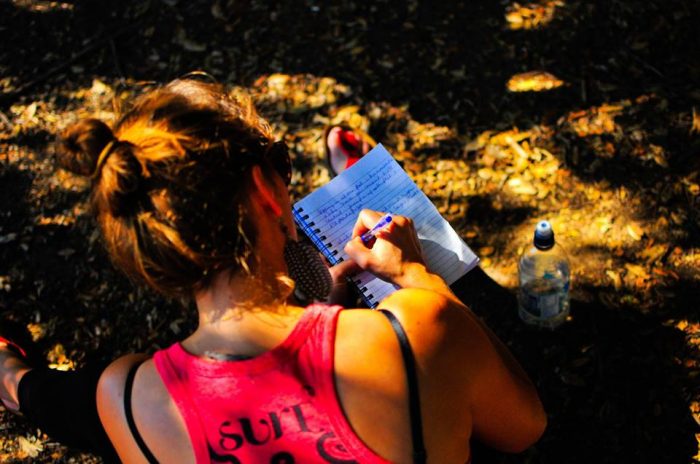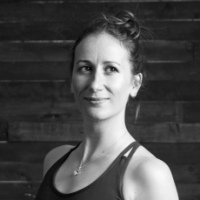I’ve been reflecting a lot recently on the power of writing.
Somehow, it’s only just become apparent to me that I’ve always written; until now, I thought it was something everybody did. It turns out they haven’t been doing it—just like I haven’t been running marathons or fixing motorbikes.
Writing’s been a constant through every job I’ve had since graduating from my English Literature BA. It’s taken me through each of my jobs in the art world, into ridiculously exciting territory with my food business, and was a way of making some additional money when I was studying for my master’s. But aside from the press releases, articles, artist interviews, or biographies I’ve tapped out for professional work, by far the most rewarding and therapeutic of my writing time has been the stuff of the pen, the words that have connected ink and paper to the flow of my mind or the ache of my heart.
During my first breakup at age 15, I wrote sheets and sheets of poetry about the first of my heart’s disappointments. I remember the process clearly, mapping out the hurt with heavy metaphor and candid feeling. And aside from finding what I put down at that tender age to be cringeworthy now, I’m glad I kept the folder of pages, each of which I remember filling with ferocious speed, tearing one sheet after another from the pad.
Nearly 15 years later, in the pitch-black pain of my dad’s battle with a brain tumour, I found myself writing through the pen again—writing letters to him (if only he could still read) and attempting to send letters out to my future self as a way of reaching beyond the agony of now. I wrote in the hope that he could hear what I wanted to say, and I wrote when sitting at his bedside was too much to bear.
A few months after his death, and when the long-term boyfriend I was hoping to marry broke my heart by walking, inexplicably, away, the act of putting pen to paper and letting the ink flow through was a step in the direction of expression. Most days were pure, felt chaos: I had lost my past and my future in one fell swoop and the only thing the present held was a pain so intense, so physical, so complex, I wished not to be alive.
Over time—a long, agonising time, during which I somehow found the motivation to write an award-winning blog, open a restaurant, and publish a cook book (isn’t it obvious that some of our best work comes from the tangled hell that lives right at the bottom of our being?)—it was a commitment to meditation, and later, yoga, that helped me to see the perfect clarity and abundance of the present moment.
The paradox seems so obvious: how can getting real and comfortable with the present moment be a tonic for the searing pain of right-now experiences?
Well, it turned out that meditation was the tool that allowed some space between me and my thoughts. And once I edged through that initially small gap, I started to be able to separate pain from stories, pain from past hurts, pain from fear of the future, and so on. Away from the maelstrom of the mind, all that was left was the pain—which, though considerable—was a more liveable, manageable phenomenon.
Of course, the practice wasn’t easy—and it isn’t for anyone, ever.
That’s why we call it practice and it’s how we come to cultivate and to nurture, rather than “succeed” or “improve at it.” The reason we return to sitting is in order to gain awareness of how the mind functions and to pay respect to the complexity of experience that is human life. Sitting, for me, is about making space, seeing with clarity what’s going on, and allowing the dust to settle.
In writing, we can find a way to label what we are feeling, much like we do in sitting meditations. The truth is, I don’t feel that there is a language for that kind of loss, nor that we’ll ever find it. But at least what is turmoil and agony on the inside finds something of a voice through the known field of language and more than anything provides a process by which to let the grief through. Putting pen to paper makes room for a stream of consciousness outside of ourselves, reminding us of our ability to reach into language and have it pull us out from the water, if only we can find the end of the rope. That, at least, is a start in releasing…releasing…releasing.
When I sit to write, I open myself to the same quality of attention that I’m cultivating in sitting practice. The blank page tempts me in the same way as the meditation cushion: in both places I must “make myself empty like a pot,” approach it with beginner’s mind, and be susceptible to doubts, fears, and second voices before letting the flow of awareness and focused attention settle me into a way of being that is at once present and transcendent. In both, I experience how the present moment ushers in the next.
As acts of discovery, both practices help me to trace the contours of my awareness, to take me deep into my truth, and to direct me back out from the vast reaches conjured by my psyche. If nothing else, writing pulls me out to the edge, into the mystery, and makes me feel less mad.
Back then, I also wrote because I knew I’d need to look back and remember how far I’d come; that, unimaginable as it was then and in every successive moment, there would—according to those around me—be a time when I’d look back and find myself in a stronger place.
I’m happy to say that time is now. There’s no more waking myself up in the middle of the night sobbing and reaching out for the pen to scratch some words into the notebook. Rather, my writing’s taken me to a place of stimulating academic enquiry where I can explore the healing connections between death and spirituality, mind-body practices, and yoga and neuroscience.
I count myself lucky, for those words have contributed to my healing. To write now from a point of resolution—one in which I find my spiritual enquiries and the facts of my life entwined, reconciled, and resolved—is about recovery (literally meaning “a return to truth”) and it is about recalling what was, what lingers, and what has been relieved.
Research shows that when we select, edit, and refine language so as to make sense of life events beyond our control, we positively impact our response to the events themselves and actively improve immune function, physical and emotional health, and behavioral changes associated with being able to act on our own behalf.
The sense of agency that comes with crafting a coherent narrative out of seemingly chaotic events that were deemed to be incomprehensible or beyond our control is crucial to the recovery of a lost self. Turning disarray into wholeness removes some of its power to hurt: we have alchemised the pain into art. Not only do we celebrate survival, passage, and courage in carefully selecting language as the representative of experiences that were found to be indescribable, but we replace feelings of hopelessness and victimization with the experience of control and authorship.
In writing, we become an observer to our pain, and so create space between shards of memory and present cognition.
Restoring control and identity through the conscious crafting of language, according to de Louise de Salvo in Writing as a Way of Healing: How Telling Our Stories Transforms Our Lives, “…we symbolically resolve the searching and the yearning stages of the mourning process into the ‘finding and having’ stage” when we unearth the right details and phrases.
Not only this, but we are enabled to create public testimony out of private endurance and can use the thought involved in ordering events, conversations, and happenings as leverage out of being drawn back into past horrors. The miracle of art-making is that it allows us to turn the mirror toward the light of our once-charred soul and to unspool the grief that lives there.
The act of linking feelings with troubling events also causes our bodies to display responses associated with yoga and meditation by working to integrate the left and right hemispheres of the brain, lower the heart rate, and relax the body. When we confront the chaos of our memories in this way, we bring unassimilated events into an integrated sense of self and personhood, and when we’re no longer working to actively inhibit the story, we alleviate the stress of holding ourselves back.
Actively inhibiting our stories, in fact, is shown to be damaging to the body’s defense mechanisms and even the biochemical workings of the brain and nervous system, resulting in cumulative stress and an increased risk of illness and stress-related problems. Confrontation of trauma, however, reduces biological stress and helps assimilate the event, becoming something we can understand and ultimately put behind us, making it less psychologically daunting. Becoming the observer of the memories, then, leads to an improvement in health and well-being.
In those post-loss years, I spent a lot of time alone: processing, thinking, reflecting, practicing, changing—building strength again.
And for the most part, however hard I searched, I still couldn’t find a way to express what I’d been through to the people I met, so I continued to write for myself. I am ever glad I returned to the page in the same way that I returned to the meditation cushion and the yoga mat: to see what was there and to let it through.
These tools have been positively life-changing—the rope, in fact, with which I could pull myself ashore again. Together, they have helped me to write a way out of the darkness, into the flow of awareness, and to find a way home.
~
Sources:
Pennebaker, James W. Opening Up: The Healing Power of Expressing Emotions. New York & London: The Guilford Press, 1997.
DeSalvo, Louise. Writing as a Way of Healing: How Telling Our Stories Transforms Our Lives. San Francisco: Harper Collins, 1999.
~







Read 3 comments and reply